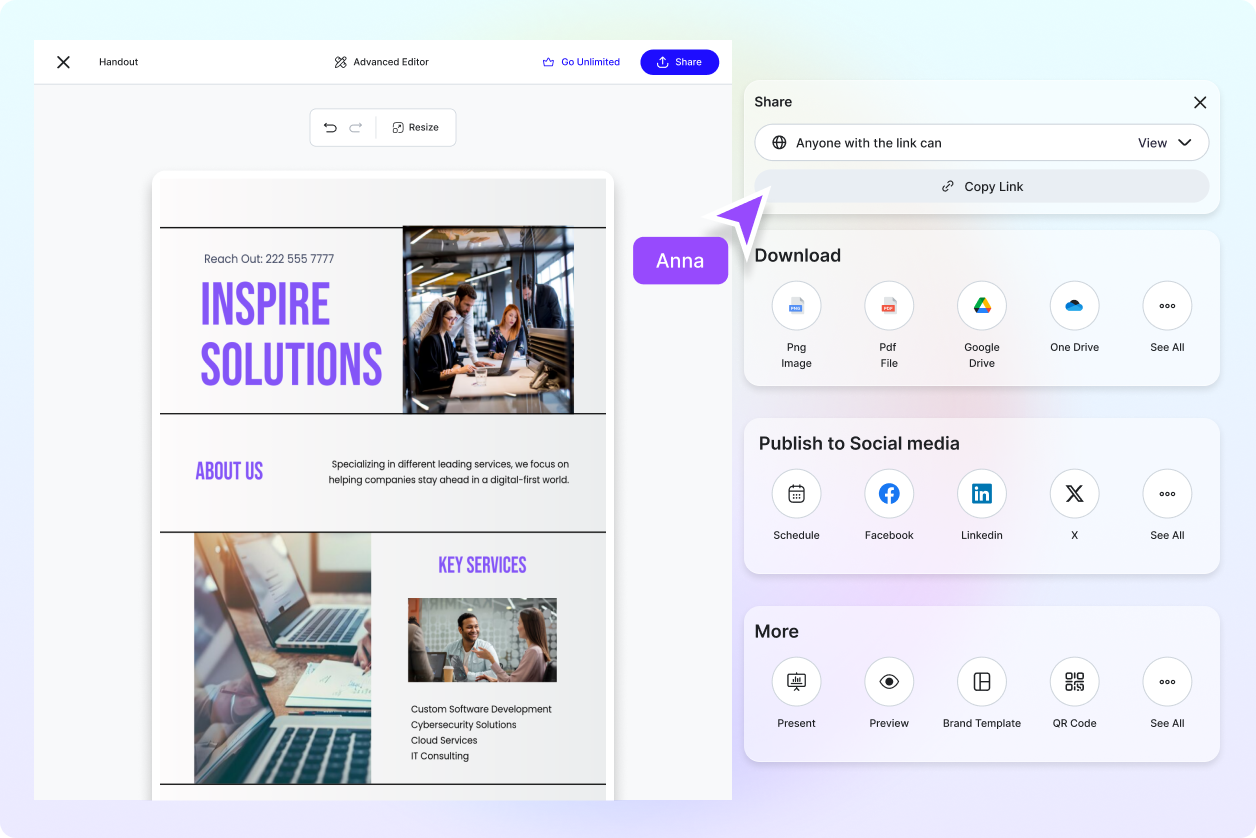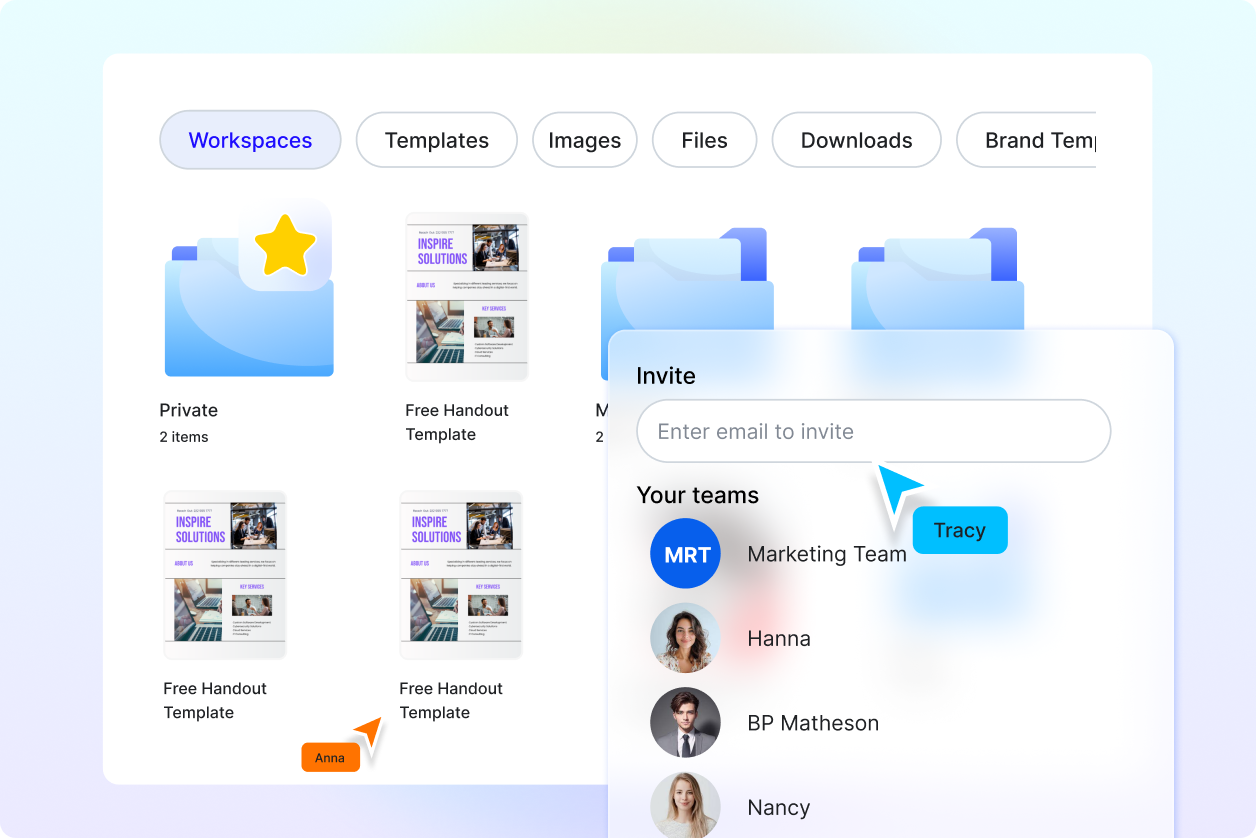Free AI Handout Generator Online
Make Handouts, Customize Online with Design Editor
Template.net’s Free AI Handout Generator transforms your ideas into clean, professional handouts ready for distribution. Whether for education, business, events, or team training, just describe what you need—our AI builds a smart layout with sections for text, visuals, instructions, and summaries. Then refine the layout, content, and design with our intuitive editor—ready for print or digital sharing.

Design Custom, Printable Handouts for Free
Print-ready and packed with purpose—designed to save time and engage your audience.
Hundreds of Pre-Designed Handout Templates
Choose from a wide range of handout templates for lessons, workshops, training guides, checklists, summaries, and more. Just select a format and customize.
Auto-Generated Layouts Based on Your Prompt
Just enter your topic or goal, then the AI creates a well-structured layout, with clearly defined headers, bullet points, graphics, and white space—so your handout is easy to read and ready to share.
Branded Content Made Easy
Apply your brand’s logo, color palette, and fonts in one click. Keep all handouts consistent with your visual identity using the Brand Kit tool.
Perfect for Educators, Trainers, and Teams
Whether you're using it as a teacher or as part of a corporate training kit, our tool adapts to your subject, age group, or tone—ensuring relevance and clarity.
Built-In Visual Assets
Enhance your handout with access to icons, illustrations, diagrams, and stock photography—all integrated into the editor.
Customizable Design and Content
Edit fonts, colors, images, and copy using our drag-and-drop editor. Add activities, questions, instructions, or tips directly into the design—so the handout feels like your own.
Multi-Language Handout Generation
Generate handouts in over 20 languages including English, Spanish, Chinese, Hindi, Arabic, Portuguese, Bengali, Russian, Japanese, French, German, Korean, Italian, Turkish, Vietnamese, Urdu, Persian, Polish, Thai, or Punjabi.
Optimized for Print or Digital Sharing
Design handouts suitable for classroom printouts, Zoom sessions, team onboarding, or sharing via cloud links and QR codes.
Free Download in High-Quality Formats
When you're ready, download your handout in HTML, PDF, PNG, or SVG formats—ideal for printing, emailing, or digital presentation. Use it once, or save it as a template for future lessons and sessions.
Time-Saving Templates
Reuse successful layouts and convert one handout into many for events, departments, or modules. Save time while scaling your materials.
Real-Time Collaboration
Work with colleagues or clients in shared workspaces. Assign roles, co-edit handouts, and finalize content faster without back-and-forth emails.
Editable at Any Time, Anywhere
Open, update, and repurpose your handouts using any device. Work from your browser on desktop, tablet, or mobile without needing extra software.

How to Make an AI-Generated Handout
No blank pages. No formatting headaches. Just your idea—turned into a polished, printable layout.
Step 1: Enter Your Prompt
Type in a short description of the handout you want. Whether it’s “safety procedure handout for warehouse workers” or “Educational handout on renewable energy for high school,” the more details you provide, the better the result.
Step 2: Choose a Layout
Browse your AI-generated handouts. Each one is structured with clear headings, balanced spacing, and purposeful visuals. Want to try a different tone or format? Refine your prompt or generate new options until it fits your needs.
Step 3: Edit, Download, and Share
Update any section using our easy drag-and-drop editor. Add your logo, switch fonts, insert graphics, or adjust the layout to match your brand or teaching style. Then download your handout in either PNG, HTML, SVG, or PDF formats for print, email, or sharing online on Facebook, LinkedIn, WhatsApp, X(Twitter), Instagram, and Reddit.
Create Professional Handouts Without Stress

Generate Informative Handouts in Seconds
Whether for classrooms, training sessions, meetings, or marketing, simply describe what you need—like “safety guidelines for employees” or “lesson summary on photosynthesis”—and let the AI build a clear, structured handout you can edit right away. Skip the blank page and get professionally designed layouts ready to use instantly.

Customize Your Handout for Any Topic
Edit sections, titles, bullet points, and visuals to match your goals. Repurpose a handout as a template for future topics, lessons, or team guides. Whether it’s for education, onboarding, or promotions, you can adapt and update your content with minimal effort, while keeping a consistent layout and format.

Print or Share Digitally—Anytime, Anywhere
Export your handout as a PDF, PNG, JPG, or HTML file—perfect for classroom distribution, email attachments, internal portals, or mobile viewing. Share via public link, QR code, or upload directly to your website or learning platform. Collaborate with colleagues or co-authors in real time to finalize and share handouts faster.

Organize and Scale with Shared Workspaces
Set up private or team-based folders to store handouts by subject, department, or project. Control who can view, edit, or reuse templates. With organized access and shared templates, your team can produce aligned, efficient handouts at scale—without version control issues or miscommunication.
Handout FAQ
What is an AI handout generator?
An AI handout generator is a tool that creates well-structured, printable handouts based on your written prompt. Whether you need an educational worksheet, seminar summary, or informational flyer, the tool transforms your input into a ready-made, editable layout.
Can I make handouts in other languages?
Yes. You can use the generator in English, Spanish, Chinese, Hindi, Arabic, Portuguese, Bengali, Russian, Japanese, French, German, Korean, Italian, Turkish, Vietnamese, Urdu, Persian, Polish, Thai, or Punjabi, and many more. Enabling you to create educational, training, or marketing content for global audiences.
What types of handouts can I create?
You can create lesson handouts, corporate guides, workshop outlines, checklists, marketing briefs, summaries, instruction sheets, and more.
Is the handout editable after generation?
Absolutely. You can update the text, layout, colors, fonts, and images using our drag-and-drop editor. Add your own branding, questions, or additional sections with ease.
In what formats can I download my handout?
You can download your handout in high-resolution HTML PDF, PNG, or SVG—suitable for both digital distribution and physical printing.
What is the standard size for a handout?
The most common handout size is 8.5 × 11 inches (US Letter). It’s widely used for educational, business, and promotional materials, both printed and digital.
Similar Free Design Generators

Design Generator

Image Generator

Logo Generator

Meme Generator

Sign Generator

Wallpaper Generator

Flyer Generator

Poster Generator

Portfolio Generator

LinkedIn Banner Generator

T-Shirt Generator

Invitation Generator

Naming Ceremony Generator

Birthday Invitation Generator

Infographics Generator

Bio Generator

Business Card Generator

Birthday Card Generator

Vision Board Generator
